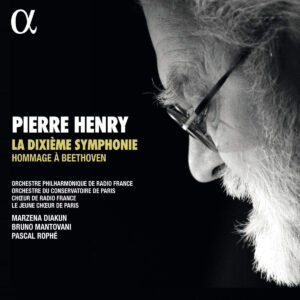Pierre Henry’s La Dixième Symphonie – Hommage à Beethoven is a work of the genre where a modern composer takes an ancient model and weaves a modern cloth around familiar and loved structures, hoping thereby to benefit from the soothing sense of the familiar and–ideally, maybe–opening the ears to a few new sounds courtesy of their own creation. It has become quite popular, too: It’s easier to sell–and play–such music to and for an audience that would otherwise be more skeptical of sheer avant-garde music. The old masters inspire respect from within; the audience’s tolerance increases notably.
Examples abound. Here are a few we have reviewed: Hans Zender’s Winterreise re-working (reviews here and here); Luciano Berio’s Rendering, its basis being sketches for what would have been Schubert’s Tenth symphony (review). More recently Bernhard Lang tortured Wagner’s Parsifal (review), Peter Gregson lobotomized Bach (review), and Enjott Schneider cribbed Ludwig (review). And Alfred Schnittke, of course, made it a defining style of his to take material of older styles and melt them into his eminently listenable brand of happy modernism. The list could be continued ad nauseam. And somewhere “ad nauseam” is where Pierre Henry’s “The Tenth Symphony” resides.
What this isn’t: It’s not an attempt at reconstructing an incomplete work–like the actual 10th symphony of Beethoven–with modern means to resemble a functioning, full-fledged modern symphony that incorporates the remnants of yesteryear into a wholly new building. (Which is what Rendering does so well.) Nor is it a contemporary reflection on Beethoven with original but Beethoven-inspired means.
What this is: All of Beethoven’s symphonies–most of the material coming from the 9th–shredded into bits and then woven into a tapestry that leaves Beethoven unmolested for large stretches at a time, only to then “splice the tape” or repeat a section or layer it with other fragments, with musical cells poking through the surface like shards of drift ice. The ingredients are all and solely Beethoven.
The beautiful aspect of that is, that shining through busy and unfamiliar matter, some isolated parts of Beethoven’s composition appear for their inherent beauty in ways in which they don’t always manage to do–or not as obviously, anyway–when they are part of the real thing, because we’re almost too familiar with it, hiding within the expected. Then it’s not unlike Wendy Carlos’ synthesized version in Clockwork Orange (1971) doing such a wonderful job pointing to the modernity of the third movement, changing our listening habits and expectations in the process.
In the liner notes the composer imagines his audience to engage in this dialogue: “Is it Beethoven? No, it’s Pierre Henry.” He continues, with a self-satisfied quip at the end: “It’s an original piece. And a precedent. Or a crime…” Well, it’s about as much Pierre Henry as my reading Ulysses in reverse order would be an original Laurson instead of simply being backward James Joyce. You never listen to any of it not thinking: “Oh, Beethoven…” In 2020 this is no longer original and it never was a crime. Just unnecessary. Not as genuine as Schnittke, not as beautiful as pure Beethoven, not as modern as echt-Pierre Henry, not as clever as Zender, not as inspired as Berio or as riotous as Bernd Alois Zimmermann’s Musique pour les soupers du Roi Ubu. It’s just bits of Beethoven’s Ninth interrupted by other bits of Beethoven–often to little more than enervating effect.
Admittedly, Henry, the leading light of Musique concrète, was well ahead of the game in this genre: A clever experiment from the mid-’70s, gutsy at the time when Henry was in his 30s and exhumed now because it’s the Beethoven year. As such, it’s much more original than Wolfgang Mitterer’s recent knob-fiddling, and curious ears might at least dip into it. The singing (Benoît Rameau) and playing of the Orchestre Philharmonique de Radio France needing three(!) conductors (like Ives’ Fourth) is absolutely decent; the sound, including the heavy page-turning, good enough.
































